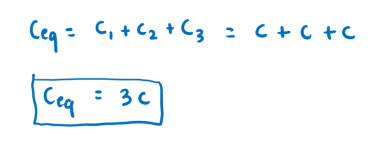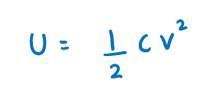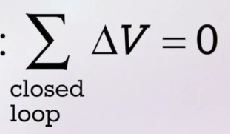(G12 EOT T1) AP physics C: Electromagnetism review 2/2
1/27
Earn XP
Description and Tags
Grade 12 EOT review by Shaikha :3 pt 2 study well!!
Name | Mastery | Learn | Test | Matching | Spaced |
|---|
No study sessions yet.
28 Terms
How do we find the equivalent resistance of a series circuit?

How do we find the equivalent resistance of a parallel circuit?

State Ohm’s law
Ohm's law states that the potential difference across a conductor is directly proportional to the
current flowing through it, provided all physical conditions and temperature, remain constant.
V = I/R
Which Kirchhoff law is based on the conservation of energy?
Loop rule

Which Kirchhoff rule is shown in this diagram?
Junction rule

Identify each term in this formula
I = current
J = current density
dA = cross sectional area

Identify each term in this equation
I = current
n = no. of electrons
A = cross sectional area
Vd = Charge of electrons
e = charge of an electron (1.6 × 10-19)

In the initial state of an RC circuit, what happens to the capacitor(s)?
It will be considered a wire.
In the steady state of an RC circuit, what happens to the capacitor(s)?
The capacitor(s) will be considered an open switch.
What is electric current?
What is the formula of electric current?
Electric current (I) is rate at which charges flow through an area.
I = current (Amperes)
Q = charge (coulombs)
t = time (secs)

What is the difference between conventional and real current?
Conventional current (I) is defined as the flow of positive charge.
Real current is the flow of the actual direction of electrons.
What is resistance?
Give the formula.
Resistance is opposition to the flow of charge.

How does temperature affect resistance?
Conductors : resistivity varies linearly with temperature
Super conductors : at a very low temperature the resistivity goes to zero
Semiconductors : for some semiconductors resistance decreases as temperature increases (refrigerators)
What are the formulas of capacitance?

What is the unit of capacitance?
Farads (F)
What is the formula of the capacitance across two plates?

What is the insulating material inserted between capacitors called?
Dielectric
What is the formula of capacitance with the presence of a dielectric material?
k = dielectric constant (given)
ε0 = 8.85 × 10-12
A = area
d = distance between capacitors

What is the formula to find the capacitance of a co-axial cable or a cylinder?

What is the formula of the capacitance of a sphere?

A parallel plate capacitor has an initial capacitance C0. How would halving the area of the plates affect the capacitance of the capacitor?
C is directly proportional to Area. Halving the area makes the capacitance half of the original value.
A parallel plate capacitor has an initial capacitance C0. How would doubling the distance of separation between the plates affect the capacitance of the capacitor?
C is inversely proportional to distance. Doubling the distance makes the capacitance half of the original value.
A parallel plate capacitor has an initial capacitance 𝐶0. The area of the plates is halved, the distance of separation is doubled and a dielectric material with dielectric constant 𝜅 = 2 is inserted in between the plates filling the entire gap. What is the ratio of the new capacitance 𝐶1 to the old capacitance 𝐶0?
Solving credit: (PhysicswithAnna on YouTube)


Each capacitor has a capacitance 𝐶. What is the equivalent capacitance for this combination of capacitors?
Since the capacitors are in parallel, the equivalent capacitance will be equal to the direct sum of each of them.
C1+C2+C3=Ceq
Image credit: (PhysicswithAnna on YouTube)


Each capacitor has a capacitance 𝐶. What is the equivalent capacitance for this combination of capacitors?
Since they are in series, the equivalent capacitance will be equal to the reciprocal of the sum of reciprocals of each capacitor.
1/Ceq= 1/C1 + 1/C2 + 1/C3

How do we find the potential energy in a capacitor?

State Kircchoff’s loop rule. (KVL)
The net potential difference within a closed loop is = 0.

State Kircchoff’s current rule.
the current flowing into a node (or a junction) must be equal to the current flowing out of it.